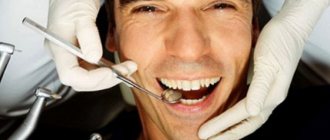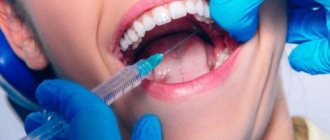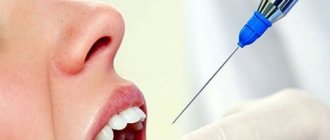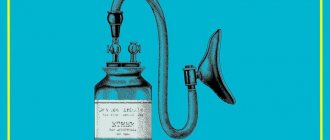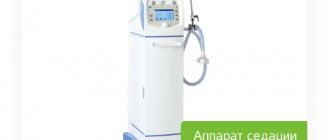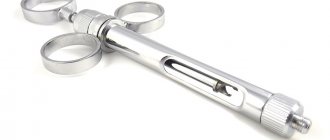The technology of intraligamentous or intraligamentary anesthesia was discovered in France at the beginning of the last century, however, today it remains one of the relevant methods of anesthesia. Anesthesia of tissues and elements of the dentition is achieved through injections of an anesthetic solution injected into the periodontal crevices. The increased pressure that occurs when the composition is supplied ensures that the main volume enters the alveolar region, and, as a consequence, into the periapical structure.
The method under consideration is characterized by a number of distinctive features, including:
- Rapid onset of analgesic effect - usually no more than a minute passes from the moment of injection;
- Maintaining the achieved state for half an hour, which is quite enough for most dental operations;
- Minimum requirements for the implementation of the protocol and the absence of painful sensations from the injection;
- No tissue numbing effect after completion of the procedure.
These properties ensure a positive response to treatment in both adults and young patients. The technology, as a rule, is recommended for the treatment of children, since it is not associated with negative side effects, and simplifies the treatment of pathologies of the jaw region.
Areas of application and contraindications
Clinical situations in which intraperiodontal anesthesia is recommended include:
- Removal of pulp and extraction of dental elements;
- Therapy aimed at treating caries in superficial and medium forms of development;
- Planning the installation of artificial crowns;
- Preparation of tooth enamel in the preparation of supporting units for dentures;
- Treatment of inflammatory processes localized in the tissues of the oral cavity.
In addition, the technique is recommended for the treatment of pregnant and young patients, which is due to the absence of pain and side effects.
Among the contraindications that limit the possibility of anesthesia in accordance with the protocol under consideration, it is worth highlighting:
- The presence of purulent formations in the periodontal structure;
- Formation of gumboil, cysts and periodontal pockets;
- The need for treatment or other procedures with the fangs.
The last limitation is due to the lower probability of a successful outcome of anesthesia, resulting in the achievement of an analgesic effect only in four cases out of ten. Such low rates are associated with the peculiarities of the anatomical structure of this category of teeth, which have an elongated root part.
Administration technique
Intraligamentous anesthesia involves the introduction of an anesthetic into the space surrounding the ligament, i.e., into the periodontium. Before giving an injection, the doctor performs several mandatory actions:
- cleansing enamel from deposits;
- sanitation of the oral cavity;
- antiseptic treatment of teeth and periodontal pockets.
The injection takes place into the gingival sulcus to a depth of 2-3 mm until the dentist feels tissue resistance.
The syringe needle should be located at an angle of 30° to the longitudinal dental axis. Having reached the stop, it turns 180° (at that moment its cut should be directed towards the alveolus).
The drug is administered slowly (over 30-60 seconds) - this is the main requirement. Simultaneously with insertion, pressing the syringe handle develops the required pressure, under the influence of which the medicine enters the tissue. The effect occurs almost immediately as soon as the dentist administers the medicine.
Types of anesthetics and injectors
For intraligamentous anesthesia, special carpule syringes are used. A wide range of models are available in dentistry, but they all meet standard criteria, which include:
- Maintaining high blood pressure during injection;
- The presence in the structure of a special liquid drainage system;
- Equipped with a rotary or angled attachment that changes the inclination of the needle.
In addition, a prerequisite is the use of materials that are resistant to sterilization procedures, ease and ease of use.
Among the popular models of carpule syringes are:
- STERINJECT and PERI-PRESS are cross-shaped products that include a latch for simultaneous fixation with four fingers. Application of muscle force allows 0.2 ml of anesthetic to be injected with each lever press;
- CITOJECT – models similar in shape to a standard fountain pen. The presence of a piston element and a comb ensures the introduction of 0.3 ml of the composition during injection;
- PAROJECT – hollow small-sized cylindrical syringes, made of metal, and delivering up to 0.6 ml of solution per press.
In addition, other models are also popular among dentists, including the Russian development IS-01-1-Mid, which is distinguished by its rotating head design.
Anesthetics used for pain relief belong to the category of capsule formulations with local action. A standard ampoule contains 1.8 ml of a solution containing an amide anesthetic and a vasoconstrictor.
Key Aspects
When carrying out the procedure, the dentist must take into account the following conditions:
- The number of anesthetic injections directly depends on the number of roots in the tooth, i.e. one injection is enough for a single-root unit, and two for two roots.
- Anesthesia of one element requires 0.12-0.19 ml of anesthetic solution.
- If the injector has a dispenser with a volume of 0.06 ml, then this amount of medication is administered slowly over 7 seconds. For a single-rooted tooth, the input is repeated up to three times with an interval of 7 seconds.
- After the injection, do not immediately pull out the needle. You need to wait about 10 seconds so that the drug does not come out.
During the procedure, the doctor makes sure that the anesthetic does not leave. If this happens, he must reduce the pressure on the piston, or the needle insertion depth was not sufficient. This also happens when the needle is pressed strongly against the root or alveolus when it is blocked.
To fix the problem, you should change the position of the injector. If there is no result, you need to check how well the medicine passes through the needle.
The main sign of correct manipulation is the appearance of pallor of the gum tissue around the anesthetized tooth.
Advantages of the technique
Among the positive aspects that characterize intraligamentary anesthesia are:
- Convenient protocol implementation that does not require special skills;
- Effective action of the composition, guaranteeing the required result in 99% of cases;
- Safety and painlessness of the procedure for patients;
- Promptly achieving the desired effect.
The technology provides correct pain relief, allowing for almost any type of dental intervention.
Preparation for the procedure
For intraligamentary anesthesia, Lidocaine, Ultracaine and Trimecaine are usually taken. All of these drugs are standard and are used in almost all methods of local anesthesia.
The procedure performed before each type of treatment is an allergy test (allergy test). If the patient has doubts or does not know his body’s reaction to a certain type of medication, this manipulation is mandatory.
The test is also performed if there is a history of:
- bronchial asthma;
- allergic rhinitis;
- hay fever;
- atopic dermatitis.
If the patient has had Kvitke's edema, anaphylactic shock, or has never had his teeth treated with anesthesia, at least once, he should warn the doctor about this. In such situations, it is also necessary to do an allergy test.
To test the drug that he plans to administer, the dentist dilutes it with saline solution. Then 0.1 ml of the resulting solution is injected intradermally into the wrist. The test result is assessed according to the following indicators:
- The reaction developed instantly - the result is positive, and means that the use of this medicine should be discontinued.
- The reaction appeared within 20 minutes . – immediate effect. Just as in the first case, the use of the drug is contraindicated.
- There is no reaction (no changes on the skin) – negative result. The medicine is allowed for use.
What drugs are used for pain relief
Based on the experience of visiting dentists, many people ask the question: why is it painful to be treated in one clinic, but not in another? The patient's sensations may depend on many factors, but the most important is the painkiller itself.
At the beginning of the last century, novocaine was actively used, and from the middle of the century they began to use a more powerful anesthetic - lidocaine. This was considered a breakthrough in medicine, but the pain could not be completely eliminated.
Modern dental clinics use painkillers based on articaine. Let's look at the most popular of them:
Ultracaine
The most commonly used anesthesia, since the drug contains a small proportion of epinephrine (adrenaline) and almost no preservatives. Available in three forms: with an adrenaline concentration of 1:100000, 1:200000 and without it at all. The analgesic effect is achieved after 10 minutes and lasts for 2-3 hours. It is used even in the presence of allergic reactions, suitable for patients with heart disease and pregnant women. Its effectiveness is very high, while it is instantly eliminated from the body and does absolutely no harm.
Ubistezin
The drug is produced in Germany. Contains adrenaline, due to which it has a vasoconstrictor effect at the injection site. The drug has 2 release forms with an adrenaline concentration of 1:200000 and 1:100000. The analgesic effect occurs after a few minutes, and the duration of action is at least 1.5 hours.
Septanest
It has been used in dentistry for quite a long time. Available in 2 forms: with an adrenaline content of 1:100000 and 1:200000. It is used in complex cases and in the absence of contraindications. Allowed for pregnant women and children over 4 years old. A distinctive feature is good tissue tolerance and moderate vasoconstrictor effect. The duration of exposure is at least 45 minutes.
Scandonest
This drug does not contain adrenaline or preservatives. Used for adrenaline intolerance. It is not used for bronchial asthma, but is suitable for patients with diabetes, thyroid diseases, allergies and the elderly. Provides fast and strong pain relief. One drawback is the short validity period. Requires repeated administration during prolonged manipulations.
Does it happen that the anesthesia does not work?
In fact, such situations are very rare. Less than 1% of all patients are sensitive to a certain type of drug, so you just need to find the right one. Here, most often the reason lies in the incorrect administration of anesthesia or incorrectly selected anesthesia.
And in conclusion, I would like to emphasize once again: do not be afraid of dentists. Today, anesthesia allows treatment to be carried out as comfortably and painlessly as possible. And the anesthetics used for pain relief are not only effective, but also safe.
Reviews
Opinions about intraligamentous anesthesia for the most part are only positive, both from dentists and from their patients.
Having a minimum number of contraindications, this technique is effective, safe and most convenient, and also facilitates easier treatment.
If you have experience in dental treatment under intraligamentary anesthesia, and you would like to express your opinion about its effectiveness and feasibility, share it in the comments to this article.
If you find an error, please select a piece of text and press Ctrl+Enter.
Tags intraligamentary anesthesia
Did you like the article? stay tuned
No comments yet
Possible complications
Despite the simplicity of the procedure, it must be performed by an experienced, highly qualified doctor. If a mistake is made, there is a possibility of adverse consequences and complications.
Such conditions include:
- Bacteremia . During the injection, in 70% of patients, microorganisms from the gingival groove are pushed into the bed of the vessel. This risk can be reduced by high-quality antiseptic treatment of the furrows.
- Injury to the ligamentous apparatus . It manifests itself as temporary pain when percussion or pressure is applied to the treated unit during the first 24-36 hours after treatment. This happens if the anesthetic was administered very quickly.
- Local necrosis of the mucosa at the site where it was pierced with a needle . It develops as a result of incorrect anesthesia, i.e., when the solution is quickly administered, the needle is incorrectly positioned, or the volume of the drug is incorrectly calculated (its excess).
The dentist’s knowledge of the anatomical structure and features of the maxillofacial apparatus, high-quality antiseptic treatment, and modern equipment will help eliminate these complications.
Prices for tooth extraction at Apex-D dentistry
| Name | rub. |
| Opening an abscess | 500 |
| Abscess drainage | 350 |
| Removal of a single root tooth | 2000 |
| Removal of a double-rooted tooth | 2500 |
| Removal of a three-root tooth | 3000 |
| Removal of the third molar “wisdom tooth” of the upper jaw | 3000 |
| Removal of the third molar “wisdom tooth” of the lower jaw | 3500 |
| Root separation | 350 |
| Hemisection | 1500 |
| Osteotomy | 1500 |
| Socket curettage | 300 |
| Tamponade with iodoform turunda | 300 |
| Alvaugille | 300 |
| Neocones | 300 |
| Stitching | 750 |
| Periostotomy | 500 |
| Hemostasis | 200 |
| Cystectomy | 3000 |
| Cystectomy with resection of the apex of one root, frontal group | 4500 |
| Cystectomy with resection of the apex of one root, chewing group | 5500 |
| Cystectomy, resection of each subsequent apex | 1500 |
| Cystotomy | 1500 |
| Cyst removal | 1000 |
| Closed curettage | 1000 |
| Open curettage of one tooth area | 1500 |
Modern dental practice makes it possible in most cases to prevent tooth extraction. The doctor’s rule is to prescribe tooth extraction surgery only as a last resort, when all available treatment methods have been tried and it is no longer possible to save the tooth, or in the event that the problematic tooth is the cause of the development of more serious complications.
